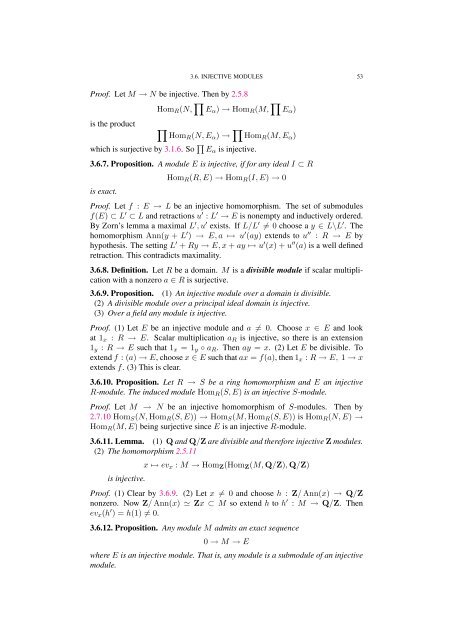Commutative algebra - Department of Mathematical Sciences - old ...
Commutative algebra - Department of Mathematical Sciences - old ...
Commutative algebra - Department of Mathematical Sciences - old ...
You also want an ePaper? Increase the reach of your titles
YUMPU automatically turns print PDFs into web optimized ePapers that Google loves.
Pro<strong>of</strong>. Let M → N be injective. Then by 2.5.8<br />
is the product<br />
3.6. INJECTIVE MODULES 53<br />
HomR(N, Eα) → HomR(M, Eα)<br />
HomR(N, Eα) → HomR(M, Eα)<br />
which is surjective by 3.1.6. So Eα is injective.<br />
3.6.7. Proposition. A module E is injective, if for any ideal I ⊂ R<br />
is exact.<br />
HomR(R, E) → HomR(I, E) → 0<br />
Pro<strong>of</strong>. Let f : E → L be an injective homomorphism. The set <strong>of</strong> submodules<br />
f(E) ⊂ L ′ ⊂ L and retractions u ′ : L ′ → E is nonempty and inductively ordered.<br />
By Zorn’s lemma a maximal L ′ , u ′ exists. If L/L ′ = 0 choose a y ∈ L\L ′ . The<br />
homomorphism Ann(y + L ′ ) → E, a ↦→ u ′ (ay) extends to u ′′ : R → E by<br />
hypothesis. The setting L ′ + Ry → E, x + ay ↦→ u ′ (x) + u ′′ (a) is a well defined<br />
retraction. This contradicts maximality.<br />
3.6.8. Definition. Let R be a domain. M is a divisible module if scalar multiplication<br />
with a nonzero a ∈ R is surjective.<br />
3.6.9. Proposition. (1) An injective module over a domain is divisible.<br />
(2) A divisible module over a principal ideal domain is injective.<br />
(3) Over a field any module is injective.<br />
Pro<strong>of</strong>. (1) Let E be an injective module and a = 0. Choose x ∈ E and look<br />
at 1x : R → E. Scalar multiplication aR is injective, so there is an extension<br />
1y : R → E such that 1x = 1y ◦ aR. Then ay = x. (2) Let E be divisible. To<br />
extend f : (a) → E, choose x ∈ E such that ax = f(a), then 1x : R → E, 1 → x<br />
extends f. (3) This is clear.<br />
3.6.10. Proposition. Let R → S be a ring homomorphism and E an injective<br />
R-module. The induced module HomR(S, E) is an injective S-module.<br />
Pro<strong>of</strong>. Let M → N be an injective homomorphism <strong>of</strong> S-modules. Then by<br />
2.7.10 HomS(N, HomR(S, E)) → HomS(M, HomR(S, E)) is HomR(N, E) →<br />
HomR(M, E) being surjective since E is an injective R-module.<br />
3.6.11. Lemma. (1) Q and Q/Z are divisible and therefore injective Z modules.<br />
(2) The homomorphism 2.5.11<br />
is injective.<br />
x ↦→ evx : M → HomZ(HomZ(M, Q/Z), Q/Z)<br />
Pro<strong>of</strong>. (1) Clear by 3.6.9. (2) Let x = 0 and choose h : Z/ Ann(x) → Q/Z<br />
nonzero. Now Z/ Ann(x) Zx ⊂ M so extend h to h ′ : M → Q/Z. Then<br />
evx(h ′ ) = h(1) = 0.<br />
3.6.12. Proposition. Any module M admits an exact sequence<br />
0 → M → E<br />
where E is an injective module. That is, any module is a submodule <strong>of</strong> an injective<br />
module.
















